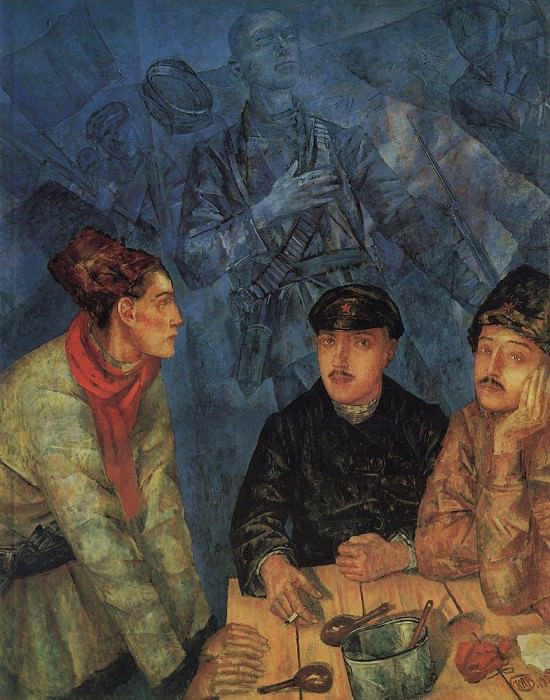After the battle. 1923 Kuzma Sergeevich Petrov-Vodkin (1878-1939)
Kuzma Sergeevich Petrov-Vodkin – After the battle. 1923
Edit attribution
Download full size: 785×1000 px (0,1 Mb)
Painter: Kuzma Sergeevich Petrov-Vodkin
Petrov-Vodkin’s painting "After the Fight," painted in 1923, was an important milestone in the artist’s painting, marking a new stage in his creative quests. Up to that moment all paintings of the artist did not have a specific time reference and were not specific in nature. The characters of his paintings could be placed in any period of time - and everywhere they would look authentic. "After the Fight" is a painting that has a clear, specific reference to the era depicted.
Description of Kuzma Petrov Vodkin’s painting "After the Fight
Petrov-Vodkin’s painting "After the Fight," painted in 1923, was an important milestone in the artist’s painting, marking a new stage in his creative quests. Up to that moment all paintings of the artist did not have a specific time reference and were not specific in nature. The characters of his paintings could be placed in any period of time - and everywhere they would look authentic.
"After the Fight" is a painting that has a clear, specific reference to the era depicted. It was not enough for the artist to depict three sad Red Army men remembering their fallen comrade. In order to strengthen the impact of his work, he depicts an episode of battle in the background, mentally rising before the eyes of the heroes. The Red Army men see their comrade precisely at the moment of his death - and this vision obscures the battle itself. It is as if the moment of death is imprinted on the back of the eyelids of everyone sitting at the table - there is no doubt that they will long remember what happened. The memory that prompted the gathering of all the participants around the table is depicted in cold blue tones, which further emphasizes the eerie essence of what is happening.
In contrast, the grieving Red Army men in the foreground of the painting are painted in warm colors, with soft strokes, making a striking contrast to the transparent dark blue background. There is no hatred or thirst for revenge on the faces of the characters - rather, a warm sadness for a comrade-in-arms who died so early. The sad, inspired images of the warriors serve as a reminder of the frailty of all life. The empty kettle on the table emphasizes the chilling emptiness at the border of life and death, which no doubt the soldiers felt. Each of them understands that tomorrow he too may be on that border - but the determination and firmness in their gazes indicate a desire to fight to the end, to victory.
Кому понравилось
Пожалуйста, подождите
На эту операцию может потребоваться несколько секунд.
Информация появится в новом окне,
если открытие новых окон не запрещено в настройках вашего браузера.
You need to login
Для работы с коллекциями – пожалуйста, войдите в аккаунт (open in new window).




















You cannot comment Why?
Behind this immediate group, the background dissolves into a spectral layering of figures – soldiers seemingly caught in moments of collapse and retreat. These forms are painted with looser brushstrokes and muted blues and grays, creating an ethereal quality that suggests memory or trauma rather than concrete reality. They appear to float within the space, their postures conveying defeat and disorientation. The artist has deliberately blurred the distinction between foreground and background, integrating these spectral figures into the scene as if they are both present and echoes of a recent conflict.
The color palette is restrained, primarily utilizing browns, greens, and blues. The red scarf provides a stark contrast, drawing attention to the woman’s presence and potentially symbolizing hope or revolutionary fervor amidst the prevailing gloom. Light falls unevenly across the composition, highlighting certain features while leaving others in shadow – a technique that reinforces the sense of psychological complexity and emotional weight.
Subtlety permeates the work; there is no overt depiction of violence or triumph. Instead, the focus rests on the human cost of conflict – the quiet suffering, the shared vulnerability, and the lingering presence of loss. The painting seems to explore not just the physical exhaustion following a battle but also the psychological toll it takes on those involved. The spectral figures in the background suggest that the trauma extends beyond the immediate moment, haunting the survivors long after the fighting has ceased. It is an image less about victory than about endurance and the fragile bonds forged in the crucible of war.